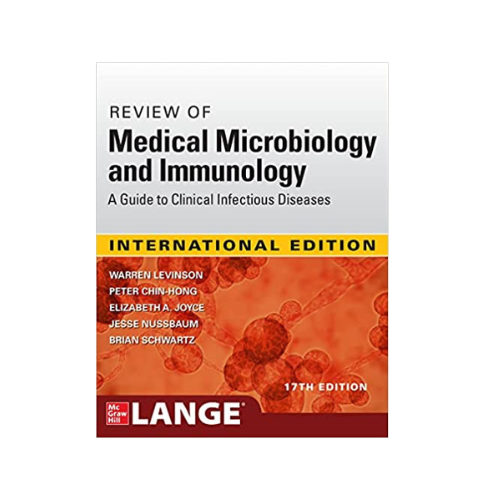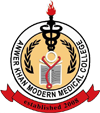Anwer Khan Modern Medical College
Library Management System

| Title: | Review of medical microbiology & immunology: a guide to clinical infectious diseases. |
| Author Name: | Warren Levinson |
| Author Sur Name: | LEVINSON,Warren. |
| Other's Author Name: | Peter Chin-Hong, Elizabeth A. Joyce, Jesse Nussbaum and Brian Schwartz. |
| Author information: |
|
| Edition/Published: | 17th ed. _New York : McGrawHill , 2022 |
|
Physical Description: xi, 836p., : <p>ill., figs., tables.</p>.; 27 cm. |
| Notes | Includes bibliographical references & indexes. |
| Includes Index: | 785-836 |
| ISBN No's: | 978-1-264-59823-6 , , |
| Bar Code's: | , , |
| Shelf Location's: | , , |
| Classification | |
| Subject: | Microbiology |
| Dewey Class No: | 616.9041 |
| LC Classification: | QR46 |
| Other's Book Information | |
| Book ID No: | 2655 , 2653 , 2654 |
| Total Books: | 3 |
| Date of collection's: | 14-Aug-2022 , 28-Nov-2025 , 28-Nov-2025 |
| Language: | English |
| Status: | Available |
| Department: | Microbiology |
| Synopsis: |
|
| Description: |
|
| Key Features: |
|
| Summary: |
"Review of Medical Microbiology and Immunology" is a highly informative and well-organized textbook that is useful for students and healthcare professionals who want to learn about the field of medical microbiology and immunology. This trusted, popular guide provides a high-yield review of the most important aspects of microbiology and immunology in a concise yet comprehensive style, This book covers both basic and clinical aspects of bacteriology, virology, mycology, parasitology, and immunology. important infectious diseases are discussed using an organ system approach, This effective mix of engaging narrative text, color images, tables, figures, Q&As, and clinical vignettes make this an invaluable, proven one-stop guide to mastering the application of microbiology and immunology to infectious diseases, This updated edition reflects the latest research, treatment, and developments, as well as enhanced information on COVID-19. |
| Abstract: |
'Review of Medical Microbiology and Immunology' is a popular textbook among medical students and professionals for learning and revising microbiology and immunology concepts. The book covers all the major topics related to medical microbiology and immunology, including bacteriology, virology, mycology, parasitology, and infectious diseases. It provides a comprehensive review of the basic and clinical aspects of these subjects, along with relevant diagrams and illustrations to aid in understanding. The book also includes review questions and answers to help reinforce the learning. |
| Preface: |
This book is a concise review of the medically important aspects of microbiology and immunology. It covers both the basic and clinical aspects of bacteriology, virology, mycology, parasitology. and immunology. It also discusses important infectious diseases, using an organ system approach. Its two major aims are (1) to assist those who are preparing for the USMLE (National Boards) and (2) to provide students who are currently taking medical microbiology courses with a brief and up-to-date source of information. The goal is to provide the reader with an accurate source of clinically relevant information at a level appropriate for those beginning their medical education. This new edition presents current, medically important information in the rapidly changing fields of microbiology and immunology. It contains many color micrographs of stained microorganisms as well as images of important laboratory tests. It also includes many images of clinical lesions and highlights current information on antimicrobial drugs and vaccines These aims are achieved by using several different formats. which should make the book useful to students with varying study objectives and learning styles: 1. A narrative text for complete information 2. A separate section containing summaries of important microorganisms for rapid review of the high-yield essentials 3. Sample questions in the USMLE (National Board) style, with answers provided after each group of questions. 4. A USMLE (National Board) practice examination consisting of 80 microbiology and immunology questions. These questions are written in a clinical case format and simulate the computer-based examination. Answers are provided at the end of each block of 40 questions. 5. Self-assessment questions at the end of the chapters so you can evaluate whether the important information has been mastered. Answers are provided 6. Clinical case vignettes to provide both clinical information and practice for the USMLE 7. A section titled "Pearls for the USMLE" describing important epidemiologic information helpful in answering questions on the USMLE The following features are included to promote a successful learning experience for students using this book: 1. The information is presented succinctly, with stress on making it clear, interesting, and up to date. 2. There is strong emphasis in the text on the clinical application of microbiology and immunology to infectious diseases. 3. In the clinical bacteriology and virology sections, the organ- isms are separated into major and minor pathogens. This allows the student to focus on the most important clinically relevant microorganisms 4. Key information is summarized in useful review tables important concepts are illustrated by figures using color. 5. Important facts called "Pearls" are listed at the end of each basic science chapter 6. Self-assessment questions with answers are included at the end of the chapters. 7. The 654 USMLE (National Board) practice questions cover the important aspects of each of the sub disciplines on the USMLE: Bacteriology. Virology, Mycology, Parasitology and Immunology. A separate section containing extended matching questions is included. In view of the emphasis placed on clinical relevance in the USMLE, another section provides questions set in a clinical case context 8. Brief summaries of medically important microorganisms are presented together in a separate section to facilitate rapid access to the information and to encourage comparison of one organism with another. 9. Fifty clinical cases are presented as unknowns for the reader to analyze in a brief, problem-solving format these cases illustrate the importance of basic science information in clinical diagnosis. 10. Color images depicting clinically important findings, such as infectious disease lesions, Gram strains of bacteria, electron micrographs of viruses, and microscopic images of fungi, protozoa, and worms, are included in the text. 11. There are 11 chapters on infectious diseases from an organ system perspective. They are written concisely and are appropriate for a medical student's introduction to this subject. These chapters include Bone & Joint Infections, Cardiac Infections, Central Nervous System Infections, Gastrointestinal Tract Infections, Pelvic Infections, Upper Respiratory Tract Infections, Lower Respiratory Tract Infections, and Infections of the Skin & Skin Structures, Urinary Tract Infections, Sepsis & Septic Shock, and Eye Infections. After teaching both medical microbiology and clinical infectious disease for many years, I believe that students appreciate a book that presents the essential information in a readable, interesting, and varied format. I hope you find that this book meets those criteria. Warren Levinson, MD, PhD San Francisco, California January 2022
|
| Content: |
Authors Page: v Preface Page: vii Acknowledgments Page: ix How to Use This Book Page: xi PART I BASIC BACTERIOLOGY Page: 1 1. Bacteria Compared With Other Microorganisms Page: 1 2. Structure of Bacterial Cells Page: 4 3. Growth Page: 15 4. Genetics Page: 18 5. Classification of Medically Important Bacteria Page: 24 6. The Human Microbiome Page: 26 7. Pathogenesis Page: 31 8. Host Defenses Page: 51 9. Laboratory Diagnosis Page: 59 10. Antibacterial Drugs: Mechanism of Action Page: 68 11. Antibacterial Drugs: Resistance Page: 85 12. Bacterial Vaccines Page: 94 13. Sterilization & Disinfection Page: 99 PART II CLINICAL BACTERIOLOGY Page: 105 14. Overview of the Major Pathogens & Introduction to Anaerobic Bacteria Page: 105 15. Gram-Positive Cocci Page: 108 16. Gram-Negative Cocci Page: 127 17. Gram-Positive Rods Page: 134 18. Gram-Negative Rods Related to the Enteric Tract Page: 146 19. Gram-Negative Rods Related to the Respiratory Tract Page: 167 20. Gram-Negative Rods Related to Animal Sources (Zoonotic Organisms) Page: 172 21. Mycobacteria Page: 179 22. Actinomycetes Page: 190 23. Mycoplasmas Page: 193 24. Spirochetes Page: 195 25. Chlamydiae Page: 204 26. Rickettsiae Page: 208 27. Minor Bacterial Pathogens Page: 213 PART III BASIC VIROLOGY Page: 219 28. Structure Page: 220 29. Replication Page: 226 30. Genetics & Gene Therapy Page: 239 31. Classification of Medically Important Viruses Page: 243 32. Pathogenesis Page: 248 33. Host Defenses Page: 256 34. Laboratory Diagnosis Page: 262 35. Antiviral Drugs Page: 266 36. Viral Vaccines Page: 277 PART IV CLINICAL VIROLOGY Page: 283 37. Herpesviruses, Poxviruses, & Human Papilloma Virus Page: 285 38. Respiratory Viruses Page: 305 39. Important Childhood Viruses Page: 318 40. Viruses That Infect the Enteric Tract Page: 327 41. Hepatitis Viruses Page: 335 42. Arboviruses, Rabies Virus, & Ebola Virus Page: 348 43. Tumor Viruses Page: 359 44. Slow Viruses & Prions Page: 371 45. Human Immunodeficiency Virus Page: 377 46. Minor Viral Pathogens Page: 390 PART V MYCOLOGY Page: 395 47. Basic Mycology Page: 395 48. Cutaneous & Subcutaneous Mycoses Page: 403 49. Systemic Mycoses Page: 407 50. Opportunistic Mycoses Page: 414 PART VI PARASITOLOGY Page: 423 51. Intestinal & Urogenital—Protozoa Page: 424 52. Blood & Tissue Protozoa Page: 433 53. Minor Protozoan Pathogens Page: 450 54. Cestodes Page: 453 55. Trematodes Page: 463 56. Nematodes Page: 470 PART VII IMMUNOLOGY Page: 489 57. Overview of Immunity Page: 489 58. Innate Immunity Page: 495 59. Adaptive Immunity: Lymphocyte Antigen Receptors Page: 507 60. Adaptive Immunity: T-Cell–Mediated Immunity Page: 518 61. Adaptive Immunity: B Cells & Antibodies Page: 532 62. Major Histocompatibility Complex & Transplantation Page: 544 63. Complement Page: 552 64. Antigen–Antibody Reactions in the Laboratory Page: 556 65. Hypersensitivity (Allergy) Page: 567 66. Tolerance & Autoimmune Disease Page: 578 67. Tumor Immunity Page: 588 68. Immunodeficiency Page: 591 PART VIII ECTOPARASITES Page: 599 69. Ectoparasites That Cause Human Disease Page: 599 PART IX INFECTIOUS DISEASES Page: 607 70. Bone & Joint Infections Page: 607 . 71. Cardiac Infections Page: 612 72. Central Nervous System Infections Page: 618 73. Gastrointestinal Tract Infections Page: 627 74. Pelvic Infections Page: 635 75. Upper Respiratory Tract Infections Page: 643 76. Lower Respiratory Tract Infections Page: 649 77. Infections of the Skin & Skin Structures Page: 655 78. Urinary Tract Infections Page: 662 79. Sepsis & Septic Shock Page: 666 80. Eye Infections Page: 670 PART X BRIEF SUMMARIES OF MEDICALLY IMPORTANT ORGANISMS Page: 677 PART XI CLINICAL CASES Page: 717 PART XII PEARLS FOR THE USMLE Page: 727 PART XIII USMLE (NATIONAL BOARD) PRACTICE QUESTIONS Page: 735 PART XIV USMLE (NATIONAL BOARD) PRACTICE EXAMINATION Page: 777 INDEX Page: 787 |
